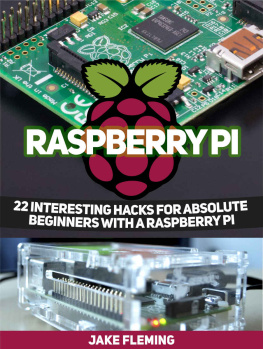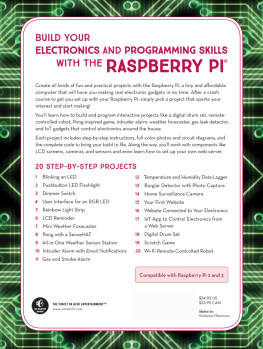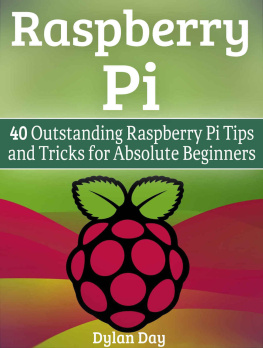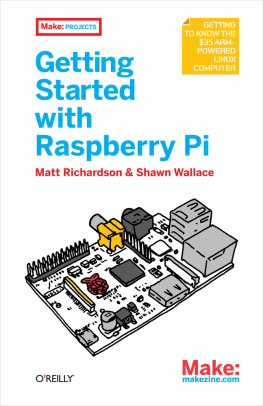Raspberry Pi
22 Interesting Hacks for Absolute Beginners With a Raspberry Pi
Table of Contents
Copyright Notice
Copyright 2015 by BA Gorilla Marketing - All rights reserved.
This document is geared towards providing exact and reliable information in regards to the topic and issue covered. The publication is sold with the idea that the publisher is not required to render accounting, officially permitted, or otherwise, qualified services. If advice is necessary, legal or professional, a practiced individual in the profession should be ordered.
- From a Declaration of Principles which was accepted and approved equally by a Committee of the American Bar Association and a Committee of Publishers and Associations.
In no way is it legal to reproduce, duplicate, or transmit any part of this document in either electronic means or in printed format. Recording of this publication is strictly prohibited and any storage of this document is not allowed unless with written permission from the publisher. All rights reserved.
The information provided herein is stated to be truthful and consistent, in that any liability, in terms of inattention or otherwise, by any usage or abuse of any policies, processes, or directions contained within is the solitary and utter responsibility of the recipient reader. Under no circumstances will any legal responsibility or blame be held against the publisher for any reparation, damages, or monetary loss due to the information herein, either directly or indirectly.
Respective authors own all copyrights not held by the publisher.
The information herein is offered for informational purposes solely, and is universal as so. The presentation of the information is without contract or any type of guarantee assurance.
The trademarks that are used are without any consent, and the publication of the trademark is without permission or backing by the trademark owner. All trademarks and brands within this book are for clarifying purposes only and are the owned by the owners themselves, not affiliated with this document.
Disclaimer
While all attempts have been made to verify the information provided in this book, the author does not assume any responsibility for errors, omissions, or contrary interpretations of the subject matter contained within. The information provided in this book is for educational and entertainment purposes only. The reader is responsible for his or her own actions and the author does not accept any responsibilities for any liabilities or damages, real or perceived, resulting from the use of this information.
Introduction
For a long time computing has been preserve of the tech literate few that controlled the fates of our social network profiles and Candy Crush scoreboards in eight fanned out fingers across a keyboard. They let us play with last year's build of whatever operating system they had stuffed into ever shrinking devices but only so long as we kept off the proverbial grass that was their code. We used to sit in dumb silence on a Sunday morning as wise men spoke the Bible to us in Latin but those Roman words were replaced with ones and zeros and mark up languages that ran to their thousands in line after line of letters arranged in robot speak.
The tech literacy of the average civilian has risen but only far enough to cover the manipulation of the smiley face put on the monolithic programs beneath, but this is beginning to change. The governments of the world, despite relying so heavily on computers, have not seen fit to teach the people how to maintain and build the machines, so methods of training us have been created at a grassroots level by basement geeks. The Raspberry Pi is the most successful project so far in achieving this.
The Raspberry Pi is a cheap, simple and extremely adaptable computer that is small enough that you can almost fit it into the watch pocket of your jeans. It comes to you naked without the usual plastic shell and it is primed to be powered with the same adapter as a mobile phone and to have the wi-fi switched on at a moment's notice.
Besides a brief stint in the 80s when the dryness of computer programming met with the reward of video gaming, learning programming has been a bit of an all or nothing process with often an unsexy carrot waiting for you at the other end. Until you have mastered computing adequately your rudimentary programming knowledge will not grant you much reward so it has to be taken further to be of real value to a human that has box sets to watch and celebrity gossip to read. Even when you had learnt enough to create something interesting it turned out that most of it had already been built and you could have more easily bought someone else's work. The pedagogy in this area was also lacking: you spent an hour, or so, each day learning how to code and in a month you could conjure a button that did nothing when you clicked it and you could centre 'Mark smells' in size 12 font.
The Raspberry Pi fixes this by giving you tangible projects to work towards - if learning to program means you have an Atari emulator you can play with your friends or a cheap way of streaming Netflix to your television. Learning how to create an ebook reader with your Raspberry Pi is much more effective for the undisciplined student than merely learning how to make an app for reading ebooks on your laptop.
Raspberry Pi not only presents a fun, goal orientated, way to learn programming and computer building but it also offer cheap and practical solutions to problems, where before putting in a computer would be unthinkable when the cost of a computer was so prohibitive. It also creates an alternative to expensive programs and devices built by large corporations by using simple guides and open source software. You'll find with lots of devices the costs break down into 10% software manufacturing costs (with needless updates and overcomplicated interfaces), 20% hardware manufacturing costs and 70% 'we charged you that much, what are you going to do about it?' costs. Raspberry Pi allows you to stand on the shoulders of programmers and hobbyists that came before you and to build machines that fit your requirement and to ditch anything superfluous. God made man but Rasperry Pi made them equal.
While arming the children of the world, first and third, with small computers that punch above their weight and giving them a platform to learn how to program in a fun environment will be the enduring effect of the Raspberry Pi this book will cover 22 projects, hacks and interesting uses for the tiny computer that could. The intention is that you will begin to see what is possible with a machine like the Raspberry Pi and see how much of an impact it can have on your life beyond a learning tool. The projects vary in how much time they require and what is expected from you but they aim to give you something that would be useful rather than a mere novelty. The bigger hope is that it will expand the ways you view the technology at your disposal and start seeing it as something that you can adapt and alter to your advantage and you'll no longer sit wondering 'when will somebody make that?'
The materials required for many of these projects are usually fairly easy to obtain and as long as you have a monitor, keyboard, a HDMI cable and a mouse, if you're Tab key isn't up to the task, then you should be able to make most of them cheaply. You will also need access to the internet to get the peripheral software that you will need for these projects but they should all be available without much work and all for the price of a Google search and a few clicks (just be careful to click on the correct download options).
BONUS: Your FREE Gift
Next page








